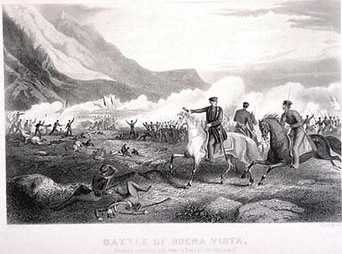Thomas in Mexico
“On the 26th of June 1845, with his Company, Lieutenant George Thomas left Fort Moultrie under orders to report to General Zachary Taylor. Company “E” arrived at New Orleans July 19th, and on the 24th under the command of Taylor, sailed for Texas, and in August, with the Third and Fourth Infantry took position at Corpus Christi, being the first United States troops to occupy the soil of Texas. With the Army of Occupation, Company “E” advanced to the Rio Grande in March, 1846, and was subsequently ordered with the Infantry and Company “I” Second Artillery, under Major Brown, to garrison the fort opposite Matamoras. These troops were subjected to bombardment from the 3d to the 9th of May. Their loss, however, was slight, but included the gallant Major Brown, who was succeeded in command by Captain Hawkins of the Seventh Infantry.

On the 9th, the siege was raised in consequence of the defeat of the Mexican army by General Taylor at Palo Alto and Resaca de la Palma, on the 8th and 9th. When the defeated Mexicans were hastily crossing the river before Taylor’s pursuing forces, the artillery fire from the forth increased their fright and confusion.
During June and July, Lieutenant Thomas was detached with a section of his battery, and was with the Vanguard in its advance to Reynosa and Camargo. Having rejoined his company, he took part in the battles about Monterey, September 21d-23d, and such was his bearing that he was brevetted Captain “for gallant and meritorious conduct.” In his report, General J. P. Henderson, commanding Texan volunteers, wrote: “I beg leave also, under the authority of General Lamar, to compliment Lieutenant Thomas of the Artillery and his brave men for the bold advance and efficient management of the force under his charge. When ordered to retire he reloaded his piece, fired a farewell shot at the foe and returned under a shower of bullets.”
General Twiggs, commanding First division, said, “Captains R. Ridgely and B. Bragg, and their subalterns, W. H. Shover, G. H. Thomas, J. F. Reynolds, C. L. Kilburn, and S. G. French deserved the highest praise for their skill and good conduct under the heaviest fire of the enemy, which, when an opportunity offered, was concentrated on them.”
The senior first lieutenant, Braxton Bragg, having been promoted to a captaincy, Lieutenant Thomas commanded Company “E” from November 21st, 1846, to February 14th, 1847, when Captain T. W. Sherman assumed command. He accompanied General Quitman’s brigade in its march to Victoria in December 1846.
In the battle of Buena Vista, February 22nd – 23rd, 1847, Lieutenant Thomas was conspicuous for efficiency and bravery, and was subsequently brevetted Major “for gallant and meritorious conduct” in this battle. The following passages from official reports prove that this reward was fully earned. General Taylor said, referring to the subalterns of the artillery, and including Thomas by name: “they were nearly all detached at different times, and in every situation exhibited conspicuous skill and gallantry.”
Captain T. W. Sherman wrote: “I was directed to take my battery back to the plateau, where I joined Lieutenant Thomas, who had been constantly engaged during the forenoon in the preservation of that important position, and whom I found closely engaged with the enemy, and that, too, in a very advanced position.
Lieutenant Thomas more than sustained the reputation he has long enjoyed in his regiment as an accurate and scientific artillerist.”
General Wool attributed the victory to the artillery: “I also desire to express my high admiration and to offer my warmest thanks to Captains Washington, Sherman and Bragg, and Lieutenants O’Brien and Thomas, and their batteries, to whose services at this point and on every part of the field, I think it but justice to say we are mainly indebted for the great victory so successfully achieved by our arms over the great force opposed to us — more than twenty thousand men, and seventeen pieces of artillery. Without our artillery, we would not have maintained our position a single hour.”
The victory at Buena Vista ended the war in Northern Mexico, but Company “E”, Third Artillery, was left with other troops south of the Rio Grande until August 20th, when the last of our forces re-crossed into Texas. “
Reference: Van Horne: The Life of Major-General George Thomas, New York, Charles Scribner’s Sons, 1882
Background song: Green Grow the Lilacs (midi file sequenced by Barry Taylor)
This is a song about a soldier’s love for a Mexican girl. One story about the song speculates that soldiers during the war liked to sing this song. Across the way, Mexicans, who could not understand the words, could only hear “GREEN GROW”. So that an Anglo-American became to be called a “Gringo” by the Mexicans.


